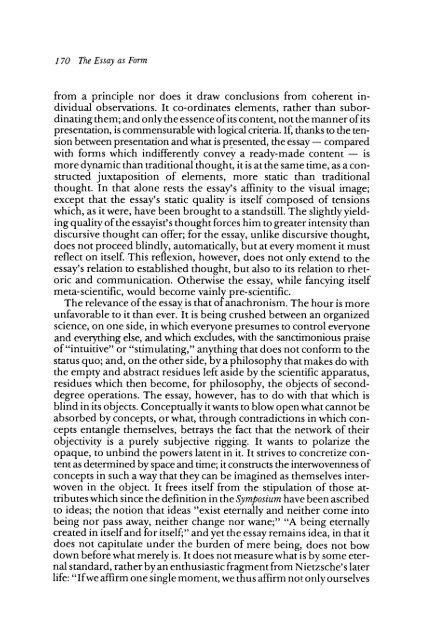Adorno-The-Essay-As-Form
Adorno-The-Essay-As-Form
Adorno-The-Essay-As-Form
You also want an ePaper? Increase the reach of your titles
YUMPU automatically turns print PDFs into web optimized ePapers that Google loves.
1 70 <strong>The</strong> <strong>Essay</strong> as <strong>Form</strong>from a principle nor does it draw conclusions from coherent individualobsenlations. It co-ordinates elements, rather than subordinatingthem; and only the essence ofits content, not the manner ofitspresentation, is commensurable with logical criteria. If, thanks to the tensionbetween presentation and what is presented, the essay - comparedwith forms which indifferently convey a ready-made content - ismore dynamic than traditional thought, it is at the same time, as a constructedjuxtaposition of elements, more static than traditionalthought. In that alone rests the essay's affinity to the visual image;except that the essay's static quality is itself composed of tensionswhich, as it were, have been brought to a standstill. <strong>The</strong> slightly yieldingquality of the essayist's thought forces him to greater intensity thandiscursive thought can offer; for the essay, unlike discursive thought,does not proceed blindly, automatically, but at every moment it mustreflect on itself. This reflexion, however, does not only extend to theessay's relation to established thought, but also to its relation to rhetoricand communication. Otherwise the essay, while fancying itselfmeta-scientific, would become vainly pre-scientific.<strong>The</strong> relevance of the essay is that of anachronism. <strong>The</strong> hour is moreunfavorable to it than ever. it is being crushed between an organizedscience, on one side, in which everyone presumes to control everyoneand everything else, and which excludes, with the sanctimonious praiseof "intuitive" or "stimulating," anything that does not conform to thestatus quo; and, on the other side, by a philosophy that makes do withthe empty and abstract residues left aside by the scientific apparatus,residues which then become, for philosophy, the objects of seconddegreeoperations. <strong>The</strong> essay, however, has to do with that which isblind in its objects. Conceptually it wants to blow open what cannot beabsorbed by concepts, or what, through contradictions in which conceptsentangle themselves, betrays the fact that the network of theirobjectivity is a purely subjective rigging. It wants to polarize theopaque, to unbind the powers latent in it. It strives to concretize contentas determined by space and time; it constructs the interwovenness ofconcepts in such a way that they can be imagined as themselves interwovenin the object. It frees itself from the stipulation of those attributeswhich since the definition in the S~)mposiumhave been ascribedto ideas; the notion that ideas "exist eternally and neither come intobeing nor pass away, neither change nor wane;" "A being eternallycreated in itself and for itself;" and yet the essay remains idea, in that itdoes not capitulate under the burden of mere being, does not bowdown before what merely is. It does not measure what is by some eternalstandard, rather by an enthusiastic fragment from Nietzsche's laterlife: "Ifwe affirm one single moment, we thus affirm not only ourselves


